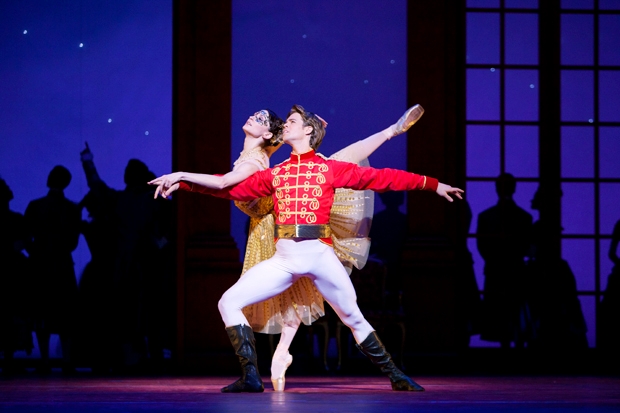What could induce a grown-up, rational, childless person to go to see the ballet of Cinderella? You’ll expect to cringe at the panto comedy; on the other hand, you do not want to see verismo child-abuse and uglies-baiting. So what’s left for modern eyes?
Two things: the Prokofiev score — as magical a charmer as Tchaikovsky’s Nutcracker — which plays with the contrasts of grotesque and beautiful, misery and hopefulness, and glistens with fairy dust in the right places. The overture melts the heart, the waltzes make you want to dance up into the sky. The sweetness of the final bars does that nearly impossible thing in music of expressing ‘and they lived happily ever after’ in a sigh of quiet relief after all the fuss and pother with sisters, shoes and all.
The other key thing is the nature of the fairy tale itself: Cinderella is about love, and about believing in love. All other classical ballets complicate the subject with egotism or lust or national duty. Cinderella is about a girl deserving love, and the boy who loves her doing everything it takes to find her. I wonder if any other theatrical art form lets you simply sit and contemplate the perfection of this idea.
I wish that Christopher Wheeldon had just done magic and meltingly loving choreography in his new version for Dutch National Ballet, and put his eager brain on hold. Blow the whole-page synopsis of the backstories to the traumatic bereavement of Cinderella and the misfit boy prince and Cinderella’s misunderstood sister and the beggar who is actually the prince who’s swapped places with his valet, etc. Truly there is merit in the great Sylvie Guillem’s synoptic style of most ballets as either ‘She dies’ or ‘They get married’.
The magic arrives here in the designs of Julian Crouch and Basil Twist. A great gale-swept tree stands for Cinderella’s dead but still nurturing mother, a stunningly imagined special effect for her pumpkin coach is done with light, wind and fabric. I wish I’d understood why potato-headed people and tarts with Anna Nicole-sized breasts are among the costumed characters when the ‘ugly’ sisters are uncourageously revised down and prettied up to avoid offence, and hence make no witty fit with Prokofiev’s capers.
It’s also surprising that a choreographer who can strike dance sparks both witty and rapt off music as different as Ligeti (Polyphonia), Pärt (Misericordes) and Gershwin (An American in Paris) seems to be skating into triviality here. The four seasons’ music — each composition deliberately distinct and separately textured — is given a bland four-part choreographic sequence whose small number of steps overlap and merge, and the sparkly, sensuous music written for the fairy godmother and her supernatural helpers is handed to four male Fates doing martial arts moves whom a colleague unimprovably tagged as Ninja Turtles.
Further disappointment — those love duets have none of the boundary-breaking intimacy that you long, above all, to see in Cinderella. These aren’t doomed lovers or beings from separate worlds; they’re going to make it and reassure us that Love Conquers All. So why have Cinderella passively carried into the ball by the Ninja Turtles, masked and encrusted in gold like a sex object? Why have her dancing with her back to the prince most of the time, and those acrobatic hoists so close to ice-skating routines? It doesn’t feel innocent, it feels vaguely exploitative to no purpose.
There’s good playing by the Royal Ballet Sinfonia, and some demanding stage technology superbly handled. But, unsurprisingly, there was dull and unresonant character-playing of unresonant characters by Matthew Golding (on loan from the Royal Ballet) and his wife Anna Tsygankova, whose tendrilly delicacy promises more than the choreography gives her.
Just the names were the necessary inducement to see the Wendy Whelan/Edward Watson show at the Linbury Studio. Here are two of the most fascinating ballet performers of our era, she a former senior star of New York City Ballet with her Picasso face and cubist boy-girl shape, all wires, no hips, and he the Royal Ballet’s leading man as well known for his almost feminine flexibility as for his potential for disconcerting intensity.
They’d had the inventive idea of having five choreographers from either side of the pond generate an hour-long sequence for them, starting with Javier de Frutos’s deceptive observational encounter and ending with a gloatingly off-colour tango by Arthur Pita, complete with knives and nudity.
It’s an entertaining ballet-cabaret show that barely hints at the capabilities of these two, but something potentially greater stirs inside it.






Comments